Foreshore animals
-
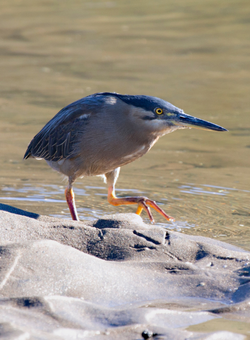
Butorides striatus
A hunched, small heron with dark grey back and grey to reddy grey underside. Black cap with droopy crest, black and white streaks on throat and sharp, long yellow and grey beak. Their short yellow legs turn orange during the breeding season. They flick their short, stubby tail as they walk.
They live on foreshores, estuaries and mangroves, hunting for fish, crabs, crustaceans and insects in the shallows all year round. Striated Heron sometimes drop a leaf or feather onto the surface of the water and snatch fish that come to investigate.
Striated Heron build a stick platform low in trees or shrubs and occasionally on the ground, which makes them vulnerable to feral and domestic predators. They lay 2 to 5 pale-blue 3.6cm long eggs. Both parents share nestbuilding, incubation and care responsibilities and may raise two clutches each breeding season.
-
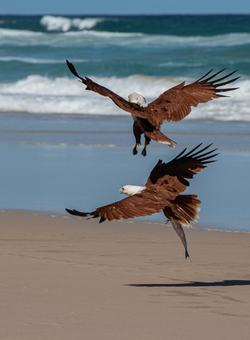
Haliastur indus
A medium sized raptor often seen above dunes and beaches, larger rivers and some wetlands. It’s bright white head and chest contrasts strongly with the reddish brown body and wings and is unmistakable.
They mostly feed on dead animals, fish and insects, but may also fish for live fish in the sea or harass other fish-eating birds and steal their prey.
Brahminy Kites breed from August to October in SEQ, and then make a stick bowl nest in coastal trees, often mangroves. They lay 2 grey-white 5cm eggs. Both parents share nest building and feeding but it looks like only the female incubates the eggs.
-
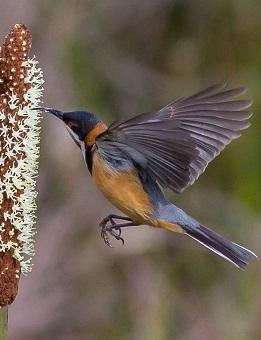
Acanthorhynchus tenuirostris
A small (15cm) bird with grey body, white throat with reddish patch, reddish and cream underside. Its distinctive thin, long, curved beak cause some people to call it the Australian Hummingbird, although it doesn’t have the flight and metabolic capabilities of true hummingbirds.
Eastern Spinebills live in forests heaths and mangroves and feed on nectar and insects often taken on the wing. While they readily feed on open flowers like grevilleas, their long beak allows them to feed on tube flowers that many other birds or mammals can’t access.
Eastern spinebills tend to live in one area all year around but may move between local lowlands and mountains. They make a small, neat cup of spiderweb, bark and twigs 1 to 45 metres off the ground. The female does the nestbuilding and incubation and both parents share feeding duties.
-
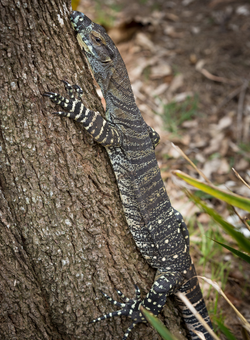
Varanus varius
A large lizard (up to 2 metres) with grey and black covering body, palish yellow spots and stripes.
Most commonly found in forests and woodlands. Spend a lot of their time on the ground but will quickly scuttle up a tree when you come close. They tuck themselves in tree hollows and hollowed stumps to hide from extreme weather conditions.
Lace monitors breed in the season of spring. During this season, the males become extremely aggressive towards other males.
-
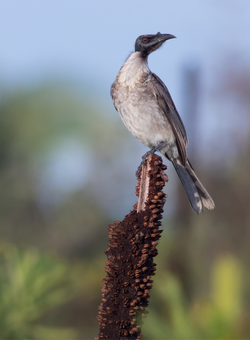
Philemon corniculatus
A medium sized bird with black head bare of feathers and silver/grey body, found in forest clearings, golf courses, parks and gardens.
They eat nectar, fruit, insects and other invertebrates and occasionally eggs or baby birds. Noisy friarbirds breed in the months between July and January and build a large, deep cup shaped nest using bark and grass.
-
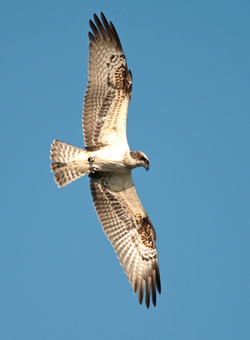
Pandion cristatus
Dark brown feathers covering its wings and small parts of its face and chest, the legs, body, and face are covered in white feathers. Length 50-65 cm, wingspan 45-170 cm.
Ospreys live near water where large numbers of fish are present. They are regularly found around large lakes, reservoirs and rivers. They are a diurnal species, ranging out from their nest or perch over water bodies during daylight.
Ospreys breed between September-October in southern Australia, April-July in northern Australia and June–August in Queensland.
-
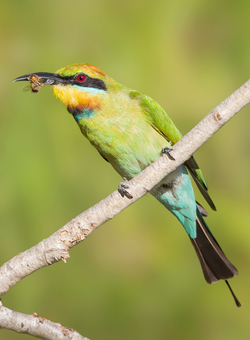
Merops ornatus
A striking medium bird with green and blue feathers covering the body, orange, yellow, green and black head and distinctive tail streamers. They are found in forest, woodlands, wetlands, heath, watercourses, lightly timbered areas, farms, playing fields, parks and gardens.
Rainbow bee-eaters are very sociable birds and roost in large groups in the dense undergrowth or in large trees outside of the breeding season. Breeding season is before and after the rainy season in the north, and from November to January in the south. They often make nest hollows in the ground, on an embankment or a cutting.
For more information
